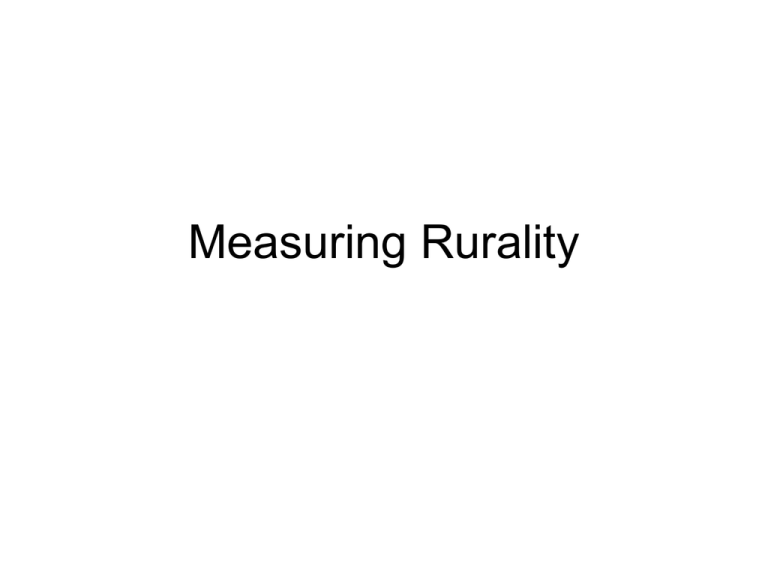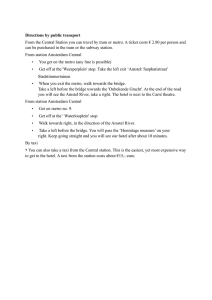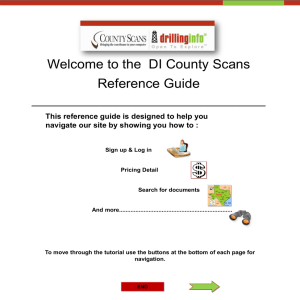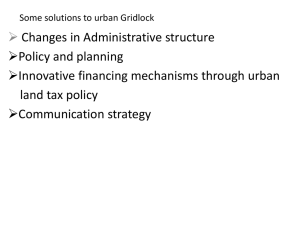Measuring Rurality
advertisement

Measuring Rurality Overview • ERS has developed several classifications to measure rurality and assess the economic and social diversity of rural America. • Rural-Urban Continuum Codes—Classifies U.S. counties by urbanization and nearness to a metropolitan area. • Urban Influence Codes—Classifies U.S. counties by size of the largest city and nearness to metropolitan and micropolitan areas. • Rural-Urban Commuting Area Codes (RUCA)— Classifies U.S. census tracts using measures of urbanization, population density, and daily commuting. • The ERS Typology Code -- classifies rural counties by their economic and policy types. U.S. Census Bureau definitions • Rural areas comprise open country and settlements with fewer than 2,500 residents. • Urban areas comprise larger places and densely settled areas around them. (That do not necessarily follow municipal boundaries). • Most counties, whether metropolitan or nonmetropolitan, contain a combination of urban and rural populations. Definitions (areas) Urban areas are of two types: • Urbanized areas – Contain urban nucleus of 50,000 or more people. (They may or may not contain any individual cities of 50,000 or more) – And must have a core with a population density of 1,000 persons per square mile and may contain adjoining territory with at least 500 persons per square mile. • Urban clusters – Have the same density criteria but are 2,899-50,000 in population • Rural areas consist of all territory located outside of urbanized areas and urban clusters. Counties: • Counties are typically active political jurisdictions • Usually have programmatic importance at the Federal and State level • Estimates of population, employment, and income are available for them annually. • They are also frequently used as basic building blocks for areas of economic and social integration. Definitions (Counties) • Metro and non-metro areas are defined by the Office of Management and Budget (OMB). • Metro counties are central counties with one or more urbanized areas • Or outlying counties that are economically tied to the core counties as measured by work commuting. – Outlying counties are included if 25 percent of workers living in the county commute to the central counties, – or if 25 percent of the employment in the county consists of workers coming out from the central counties—the so-called "reverse" commuting pattern. • Non-metropolitan counties are all counties that do not fit this definition County status 2003 Rural-Urban Continuum Codes Metro counties: 1 Counties in metro areas of 1 million population or more 2 Counties in metro areas of 250,000 to 1 million population 3 Counties in metro areas of fewer than 250,000 population Nonmetro counties: 4 Urban population of 20,000 or more, adjacent to a metro area 5 Urban population of 20,000 or more, not adjacent to a metro area 6 Urban population of 2,500 to 19,999, adjacent to a metro area 7 Urban population of 2,500 to 19,999, not adjacent to a metro area 8 Completely rural or less than 2,500 urban population, adjacent to a metro area 9 Completely rural or less than 2,500 urban population, not adjacent to a metro area 2003 Urban Influence Codes Code Descriptions counties population area density Metropolitan counties: 1 In large metro area of 1+ million residents 413 149,224,067 267,423 558.0 2 In small metro area of less than 1 million residents 676 83,355,873 629,671 132.4 92 5,147,233 94,178 54.7 Non-metropolitan counties: 3 Micropolitan area adjacent to large metro area 4 Noncore adjacent to large metro area 123 2,364,159 88,229 26.8 5 Micropolitan area adjacent to small metro area 301 14,668,144 285,527 51.4 6 Noncore adjacent to small metro area and contains a town of at least 2,500 residents 358 7,855,590 334,361 23.5 7 Noncore adjacent to small metro area and does not contain a town of at least 2,500 residents 185 1,879,264 336,499 5.6 8 Micropolitan area not adjacent to a metro area 282 9,139,821 338,256 27.0 9 Noncore adjacent to micro area and contains a town of at least 2,500 residents 201 3,227,833 193,200 16.7 10 Noncore adjacent to micro area and does not contain a town of at least 2,500 residents 198 1,313,175 196,269 6.7 11 Noncore not adjacent to metro or micro area and contains a town of at least 2,500 residents 138 2,247,189 488,521 4.6 12 Noncore not adjacent to metro or micro area and does not contain a town of at least 2,500 residents 174 999,558 285,304 3.5 Links • Measuring rurality • Rural trends (amber waves and Rural America at a glance) • Data sources on codes and other measures







